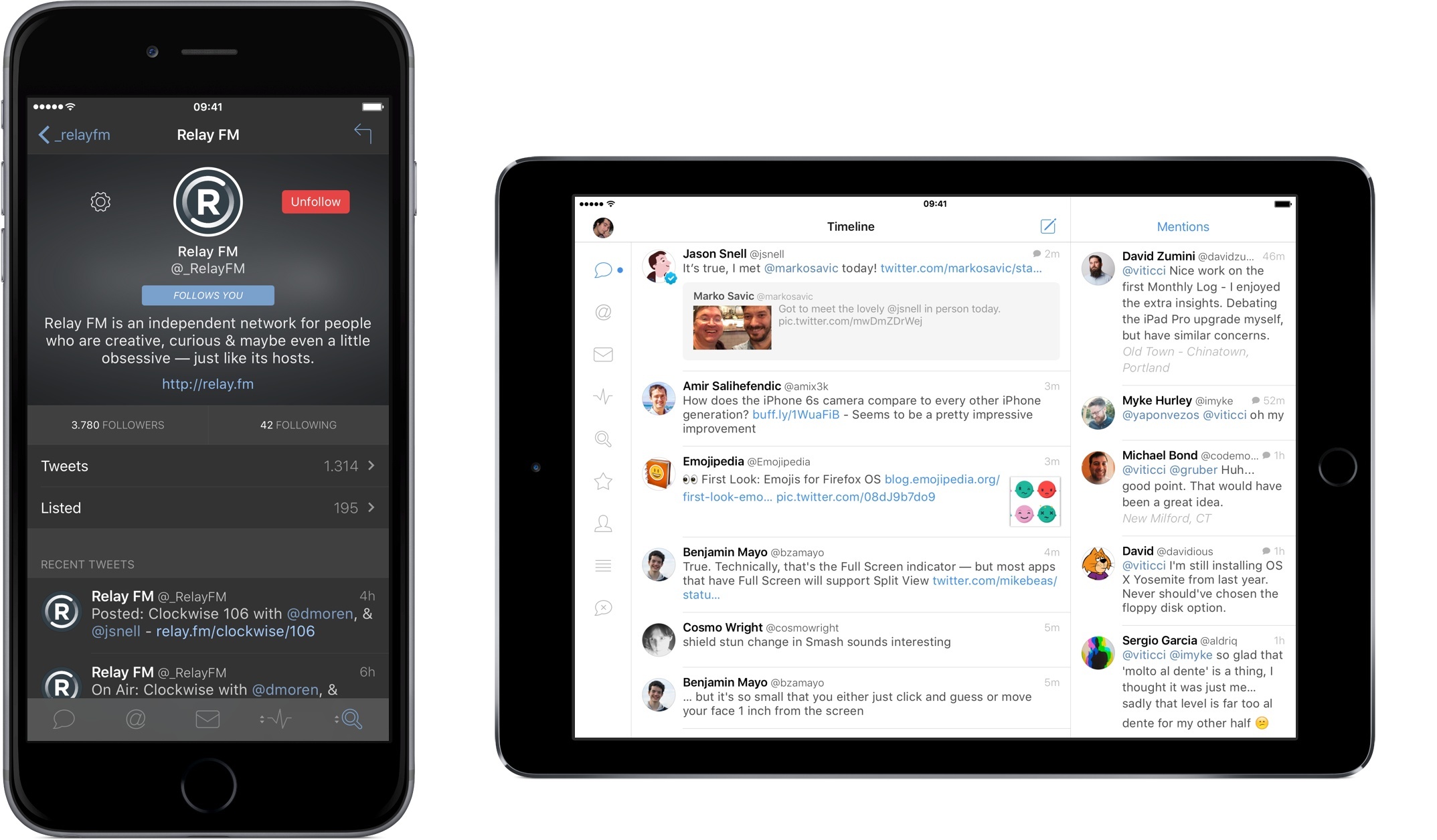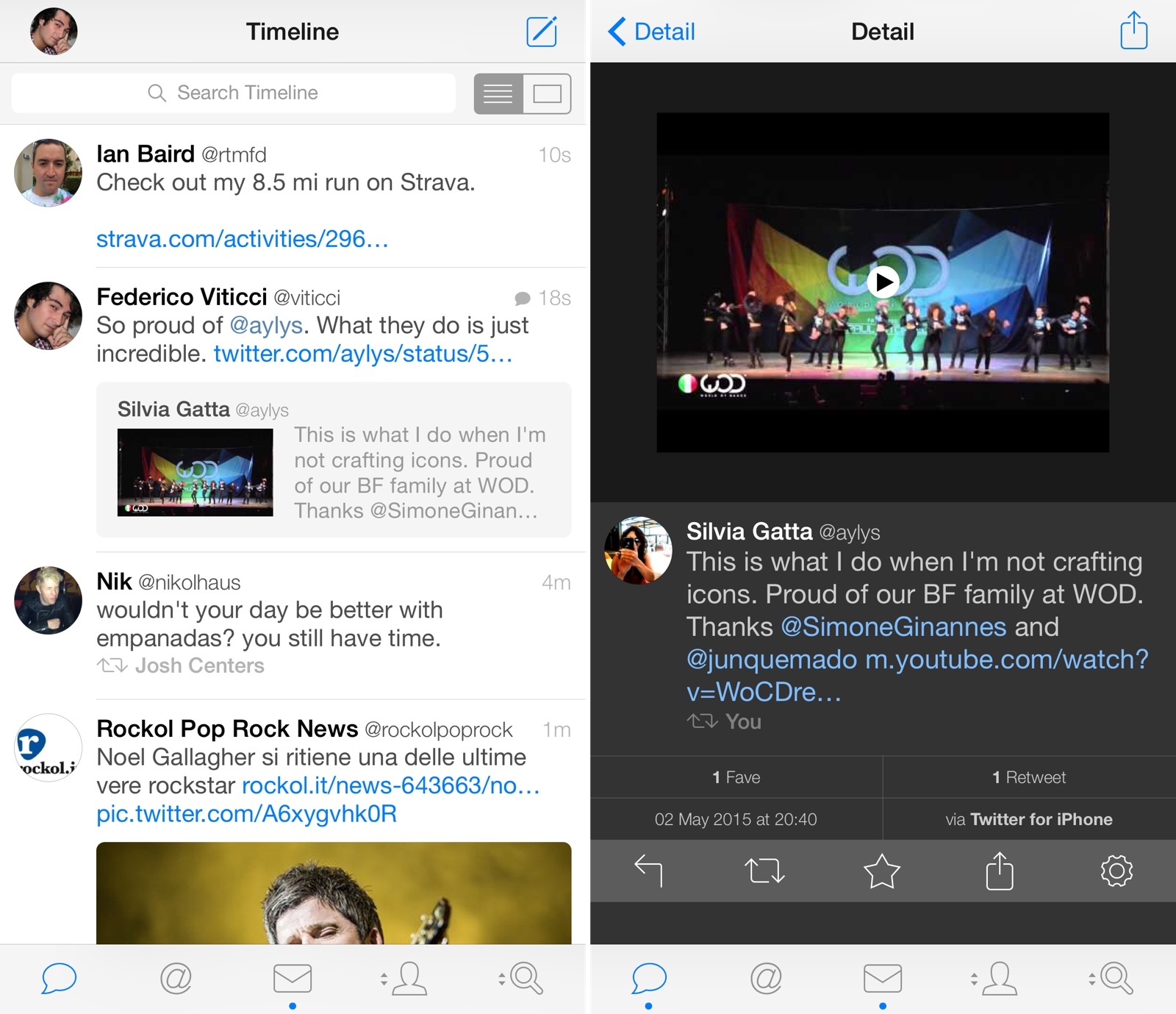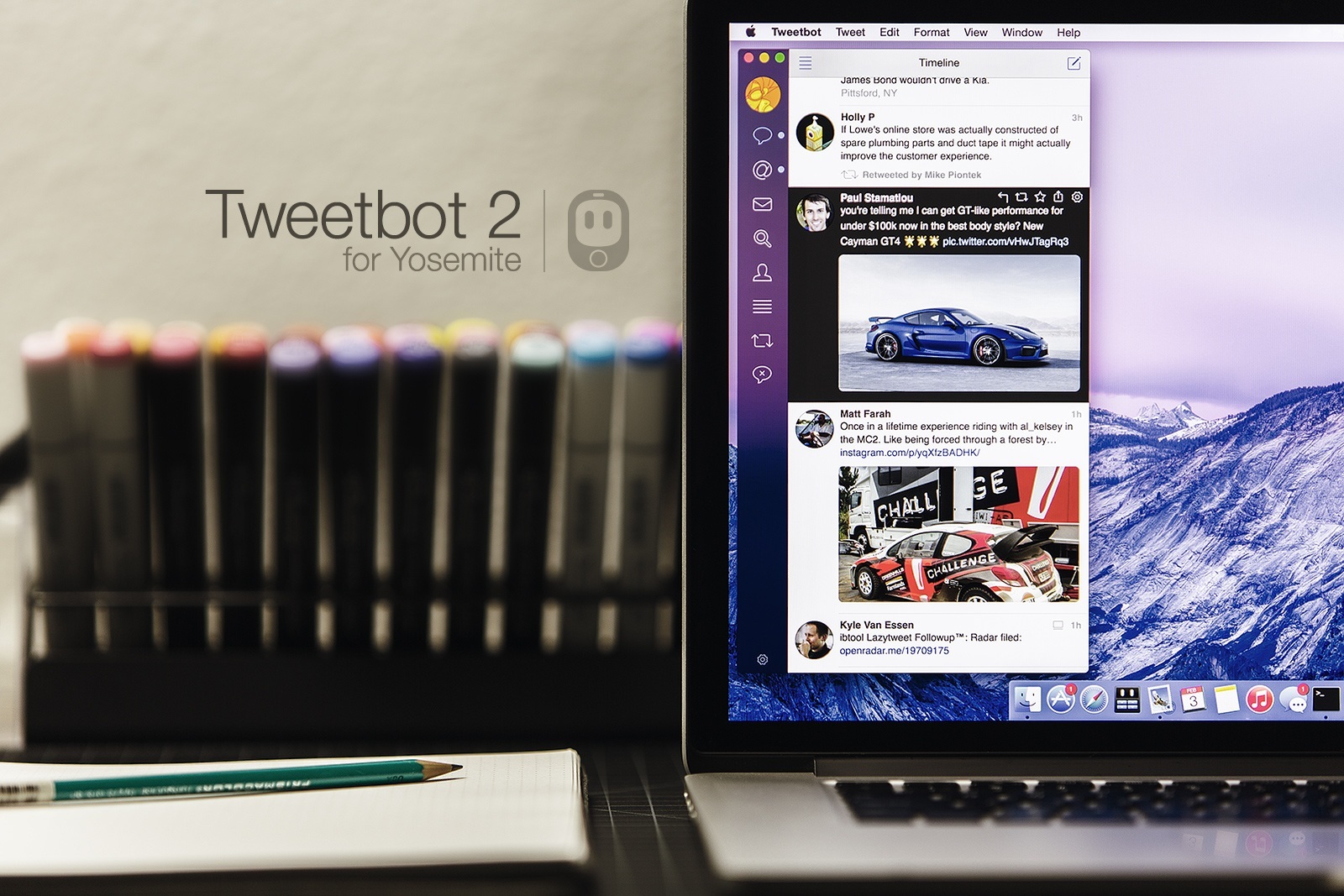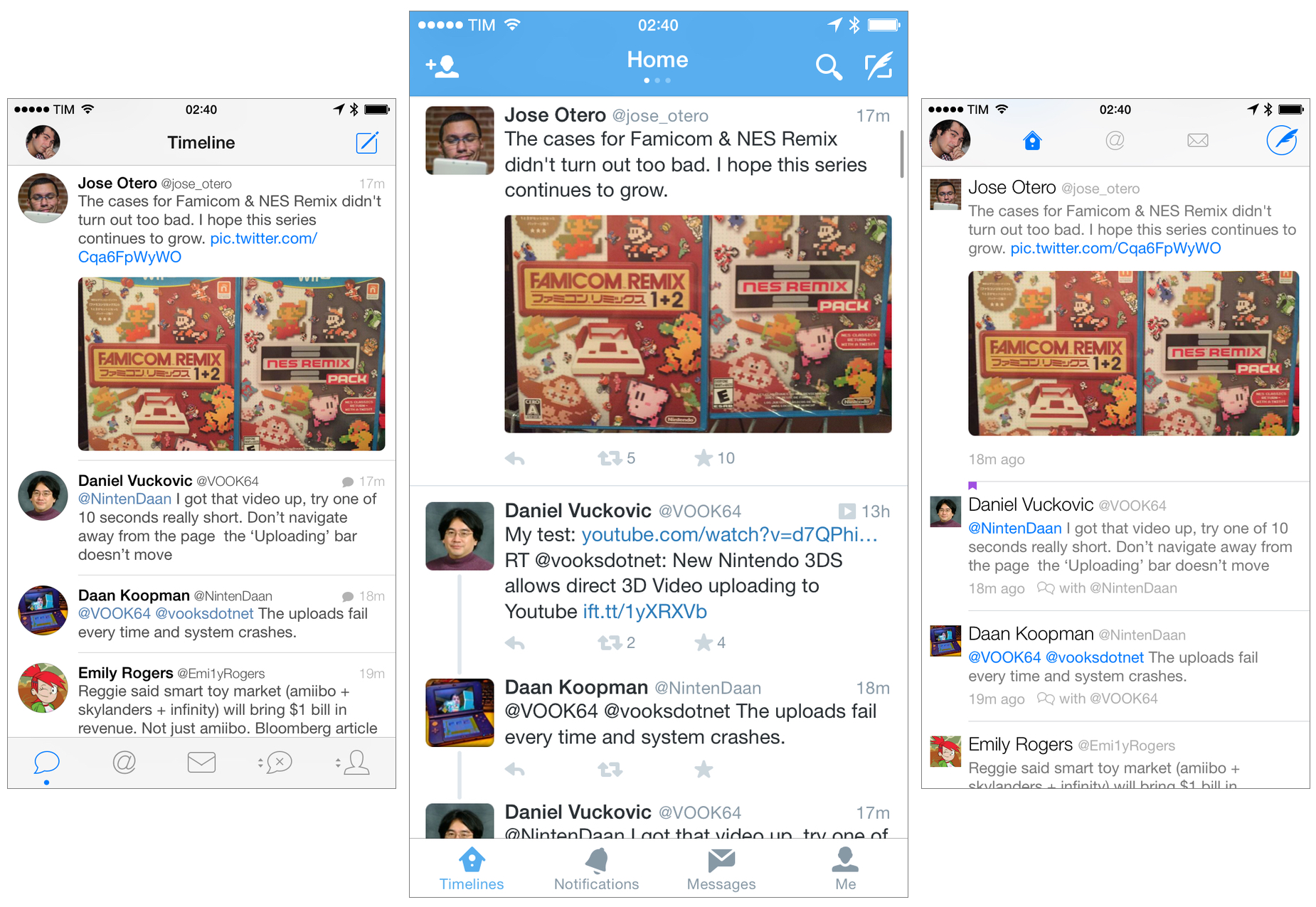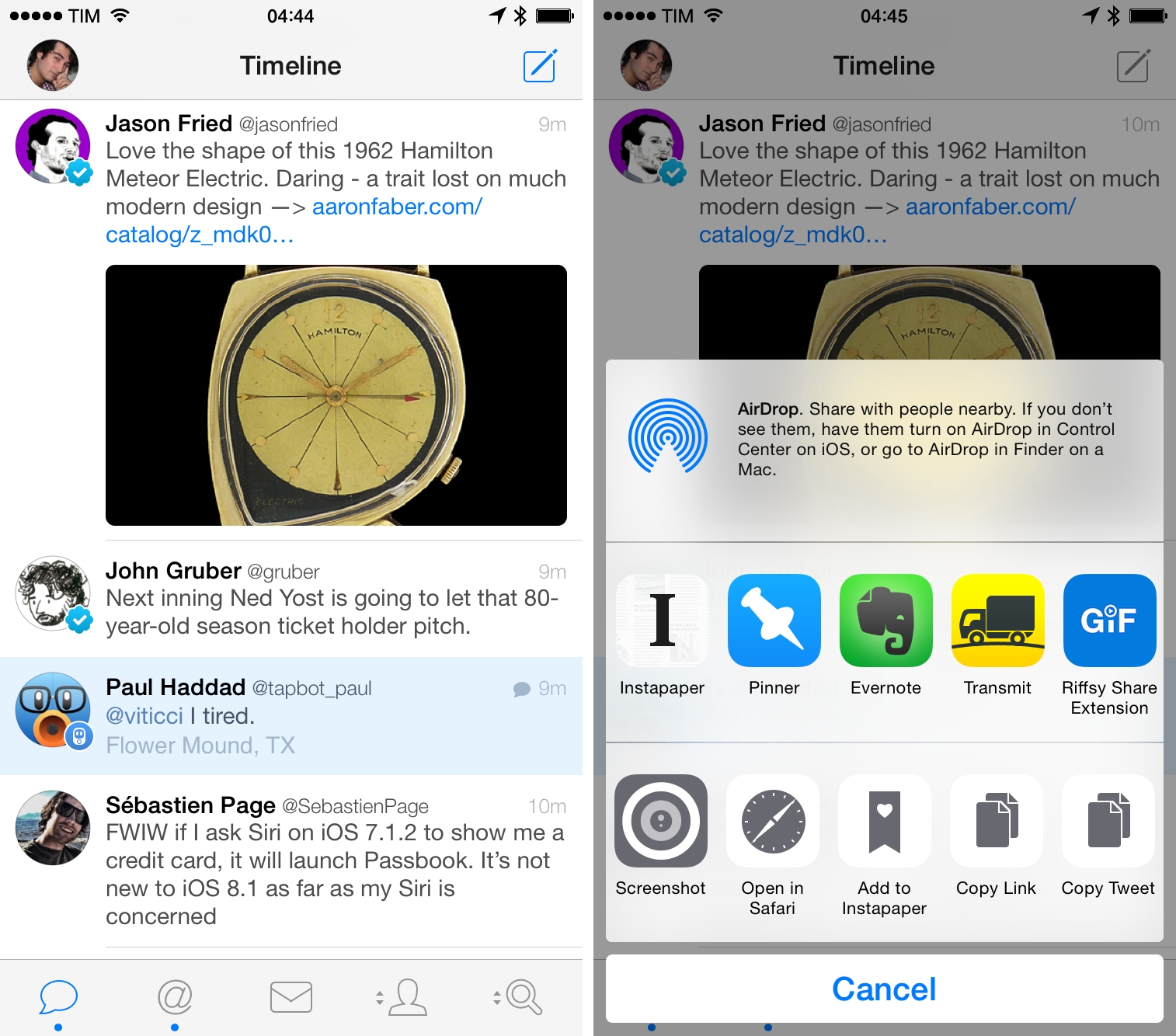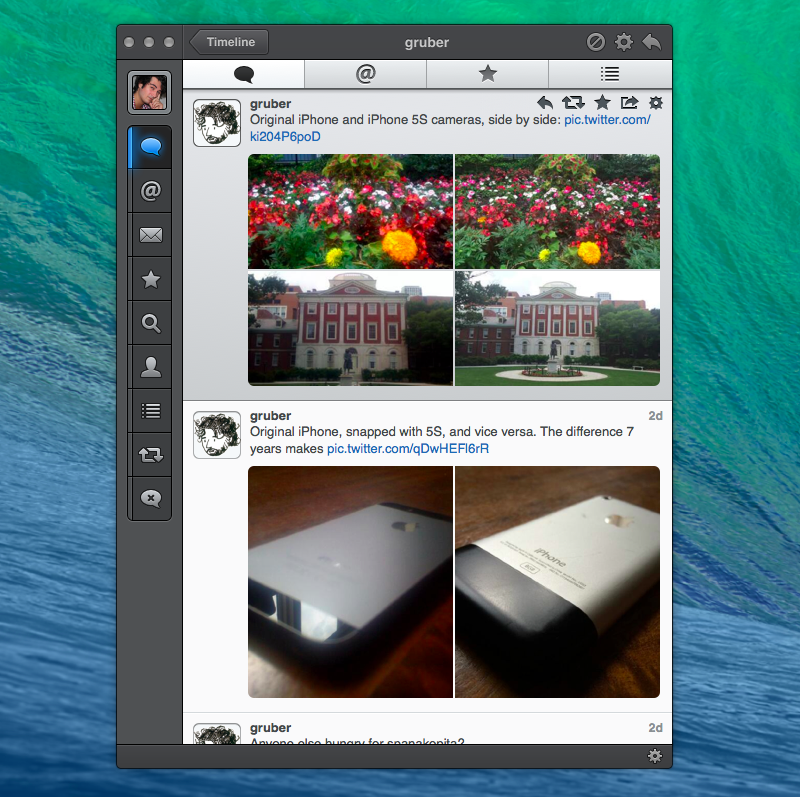Today, Tweetbot for Mac has been updated to version 2.1, which brings the same Activity page seen in Tweetbot 4 for iOS, better support for quoted tweets, in-app video playback, and several other improvements. Notably, you can now view images shared in Direct Messages (you’ll still have to share them from the official Twitter app, though), the search popover for users has been simplified, and you can now select and define words in tweet detail views. A good update for Mac users, with some welcome parity with the iOS version.
Posts tagged with "tweetbot"
Tweetbot 2.1 for Mac→
Tweetbot 4 Review: Bigger Bot
There have only been two great Twitter apps for iPad since 2010: Loren Brichter’s Twitter, and the original Tweetbot for iPad.
As I reminisced last year in my look at the state of Twitter clients, iOS apps for Twitter are no longer the welcoming, crowded design playground they once were. Developing a Twitter client used to be an exercise in taste and restraint – a test for designers and developers who sought to combine the complex networking of Twitter with a minimalist, nimble approach best suited for a smartphone. Twitter reclaimed their keys to the playground when they began offering “guidance” on the “best opportunities” available to third-party developers. Four years into that shift, no major change appears to be in sight.
For this reason, I’d argue that while the iPhone witnessed the rise of dozens of great Twitter clients in their heyday, the iPad’s 2010 debut played against its chances to receive an equal number of Twitter apps specifically and tastefully designed for the device. Less than a year after the original iPad’s launch (and the Tweetie acquisition), Twitter advised developers to stop building clients that replicated the core Twitter experience; a year later, they started enforcing the 100,000-token limit that drove some developers out of business. Not exactly the best conditions to create a Twitter client for a brand new platform.
Largely because of the economic realities of Twitter clients, few developers ever invested in a Twitter app for iPad that wasn’t a cost-effective adaptation of its iPhone counterpart. Many took the easy route, scaling up their iPhone interfaces to fit a larger screen with no meaningful alteration to take advantage of new possibilities. Functionally, that was mostly okay, and to this day some very good Twitter apps for iPad still resemble their iPhone versions. And yet, I’ve always felt like most companies had ever nailed Twitter clients for a 10-inch multitouch display.
With two exceptions. The original Twitter for iPad, developed by Tweetie creator and pull-to-refresh inventor Loren Brichter, showed a company at the top of their iOS game, with a unique reinterpretation of Twitter for the iPad’s canvas. The app employed swipes and taps for material interactions that treated the timeline as a stack of cards, with panels you could open and move around to peek at different sets of information. I was in love with the app, and I still think it goes down in software history as one of the finest examples of iPad app design. Until Twitter ruined it and sucked all the genius out of it, the original Twitter for iPad was a true iPad app.
And then came Tweetbot. While Twitter stalled innovation in their iPad app, Tapbots doubled down and brought everything that power users appreciated in Tweetbot for iPhone and reimagined it for the iPad. The result was a powerful Twitter client that wasn’t afraid to experiment with the big screen: Tweetbot for iPad featured a flexible sidebar for different orientations, tabs in profile views, popovers, and other thoughtful touches that showed how an iPhone client could be reshaped in the transition to the tablet. Tapbots could have done more, but Tweetbot for iPad raised the bar for Twitter clients for iPad in early 2012.
Three years later, that bar’s still there, a bit dusty and lonely, pondering a sad state of affairs. Tweetbot is no longer the champion of Twitter clients for iPad, having skipped an entire generation of iOS design and new Twitter features. Tweetbot for iPad is, effectively, two years behind other apps on iOS, which, due to how things turned out at Twitter, haven’t been able to do much anyway. On the other hand, Twitter for iPad – long ignored by the company – has emerged again with a stretched-up iPhone layout presented in the name of “consistency”. It’s a grim landscape, devoid of the excitement and curiosity that surrounded Twitter clients five years ago.
Tweetbot 4 wants to bring that excitement back. Long overdue and launching today on the App Store at $4.99 (regular price will be $9.99), Tweetbot 4 is a Universal app that builds upon the foundation of Tweetbot 3 for iPhone with several refinements and welcome additions.
In the process, Tweetbot 4 offers a dramatic overhaul of the iPad app, bringing a new vision for a Twitter client that’s unlike anything I’ve tried on the iPad before.
Why I Switched My Favorite Twitter, RSS, and Podcast Apps for Three Weeks
For at least five years there have been three slots on my iPhone Home screen dedicated to apps for Twitter, RSS, and podcasts. For as long as I can remember, they have been taken up by Tweetbot, Reeder and Castro. Three weeks ago I got rid of all three, and replaced them with Twitteriffic, Unread, and Pocket Casts. I had come to the awkward realisation that although I frequently tried new apps (and occasionally reviewed them), I didn’t do the same thing when it came to Twitter, RSS, and podcast apps – at all. I had become too comfortable with the same apps.
So for three weeks I’ve been solely using those apps, and this “experiment” has lead to a few interesting revelations to me. Perhaps the most obvious one was that I discovered certain features I really liked, but had no idea I liked, until they were missing in the app I switched to (and vice versa). I won’t spoil the results, but suffice to say I have resolved to try new apps (whatever their purpose) more frequently, even if I’m really happy with the app I’m currently using.
Tweetbot Adds Support for New Twitter ‘Quote’ Feature
An update to Tweetbot released last Friday has introduced support for Twitter’s new ‘quote’ feature, which allows to add comments to tweets without wasting text and while still embedding the original message with a nice preview.
The feature, first launched by Twitter in its iPhone app last month, allows Tweetbot users to quote tweets by adding their comments before a twitter.com URL. When a tweet is sent in Quote mode, the comments will be displayed on top of the original tweet, which will be shown as an inline preview that carries the original user’s profile name, username, a truncated version of the tweet, and any included Twitter photo. This is closely modeled after Twitter’s own quote style, which also embeds tweets with text and images.
Version 3.6 of Tweetbot with the new quote feature is available on the App Store. Twitterrific, iOS’ other popular third-party Twitter client by The Iconfactory, hasn’t been updated with support for quoted tweets yet, but, considering the addition in Tweetbot, I hope it’ll follow soon with its own take on the functionality.
Tapbots Relaunches Website, Working on Tweetbot 4.0 for iOS→
The fine folks at Tapbots have relaunched their website today, focusing on the apps they’re currently selling on the App Store as well as details on upcoming updates. From their blog post:
Welcome to the new tapbots.com! We hope this long overdue refresh is a better place to stay up to date with our apps. Our goal this year is to not only ship updates on a more regular basis, but also provide more insight into what we are currently working on. So lets get on to the important bits of information.
With the refresh, Tapbots has pulled Convertbot from the App Store (its core functionality is built into the newly released Calcbot 2), removed Pastebot, and set Weightbot free.
On the homepage, Tapbots confirms that a major update to Tweetbot for iOS (version 4.0) is in the works with iPad and landscape support, a redesigned profile view, and more. Tweetbot 3.0 was a fantastic take on Tapbots’ Twitter client (and it stacks up well to other Twitter apps on iOS) and, between this and Tweetbot for Yosemite, I’m excited to see more Tapbots software in 2015.
Tweetbot 2.0 for Mac Coming As Free Update→
Tapbots announced today that Tweetbot 2.0 for Mac will be released on Yosemite and it’ll be a free update for existing customers.
Tweetbot for Yosemite has been more work than anticipated, but it is coming…and yes, it will be a free update! http://t.co/HOQI4fSdsO
— Tweetbot by Tapbots (@tweetbot) February 4, 2015
My preference on iOS these days may go to Twitter’s official app, but, on the desktop, Twitter for Mac is in a very sad state, whereas Tweetbot is a great client with tons of handy features. I’m curious to see if Tapbots will manage to add support for modern Twitter features, but, overall, the visual refresh is already looking good. Considering that it’ll be a free update, you can buy the app today from the Mac App Store, get your Twitter token in, and wait for the new version to launch.
Twitter Clients in 2014: An Exploration of Tweetbot, Twitterrific, and Twitter for iOS
Twitter clients used to be a UI design playground. The growing popularity of Twitter, an open API, and the rapid takeoff of the App Store contributed to the creation of a defining genre of mobile software in 2009 and 2010: the Twitter client for iPhone. In the golden days of third-party Twitter apps, a good new client would come out at least every month, with several developers pitching their own ideas for what was meant to be a mobile-first communication network.
iPhone apps and the Twitter API were a perfect match five years ago. Twitter made sense as a social network in your pocket; Apple’s iPhone OS and newly launched App Store made that a reality. As a user, there was little friction in trying multiple Twitter clients: because Twitter data was always “in the cloud”, changing clients was like choosing a different outfit each day. The core Twitter experience would always be the same; the design and preferences around it would differ from client to client.
That was a time of astonishing innovation in mobile app design. Twitterrific, the first native Twitter client for iPhone, effectively invented key aspects of modern Twitter interaction and terminology; Tweetie, perhaps the most popular Twitter client of its time, pioneered touch interaction paradigms such as pull to refresh. And then there were Weet, Osfoora, Birdfeed, Twittelator, Echofon, Tweetings, TweetList, and dozens of other apps that helped refine and redefine the idea of what Twitter on an iPhone could be.
Good Twitter clients weren’t easy to create, but the challenge they packed was intriguing and flexible. As a Twitter developer, you needed to design an app that would primarily display textual information (this was before Twitter photos), handle hyperlinks, manage interactions between users, account for different network conditions, possibly integrate with third-party sharing services years before iOS 8, and, most of all, be fast, responsive, and easy to use. The constraints of Twitter clients in 2009/2010 freed many from the struggle of coming up with an original app idea.
If you’re using an iOS app[1] today, there’s a good chance some of its features or design ideas first appeared in a Twitter client five years ago.
We know how the story moved forward. In April 2010, Twitter realized that they needed an official iOS presence on the App Store, so they bought Loren Brichter’s Tweetie, relaunched it as Twitter for iPhone, and Brichter released the (unsurprisingly genius) Twitter for iPad.[2] For a while, it looked like Tweetie would live on, but then Twitter started adding questionable features to it, and it became clear that the third-party Twitter client would be persona non grata on the App Store.
Over the years, there have been countless examples of Twitter prioritizing their own app and a closed ecosystem approach over third-party developers and improvements to the API. From the infamous quadrant and token limits to the display guidelines and constant reticence about bringing new features to the API, Twitter has been nebulous in providing an official stance on third-party clients after the Tweetie acquisition, but the subtext of their announcements has always been fairly clear to everyone in the third-party scene. Twitter wanted people to use their official app, not a third-party client.
Before the Twitter acquisition in 2010, I was using a bunch of third-party clients but I had eventually elected Tweetie as my preferred one. After Brichter’s app turned into Twitter for iPhone, I stuck to it for a while, but then I was allured by Tapbots’ promise of a Twitter client for power users. As I wrote in my original review, Tweetbot had everything I was looking for, and that was before Tapbots would bring fantastic new features that made it even more versatile.
I loved Tweetbot in a way that I didn’t love any other app for iOS. I have extremely vivid and personal memories of getting the first beta builds of Tweetbot for iPhone and iPad, and, until Editorial came around, Tweetbot was the app I spent most of my days in. From 2011 until earlier this year, I used Tweetbot every working hour of every day. Tweetbot was Twitter for me.
That’s not to say that I stopped checking in on the state of other Twitter clients for iOS, but I certainly became less curious because I had found the one. I’ve primarily continued to keep an eye on Twitterrific, but I largely ignored the third-party space for two years. Last year, the launch of iOS 7 motivated me to look for new Twitter clients again and I stumbled across new versions of TweetLogix, Echofon, and Tweet7, but my affection for Tweetbot and the fact that the majority of my Internet friends were using Tapbots’ app convinced me that I didn’t have to look for anything else.
I like to think that I’m naturally curious, but, for my Twitter client of choice, I had become complacent and fixated on the belief that the official Twitter app could never offer anything valuable again. Earlier this year, an idea started poking me in the back of my mind: if the rest of the world is using the Twitter app for iOS, shouldn’t I give it another chance?
This realization came from a simple occasion: I was having dinner out with some friends, and I noticed that they were using the Twitter app for iPhone to read news and follow their favorite celebrities. Tweetbot was Twitter for me and I was certain that I could never switch to another app, but they seemed to be just fine with the official app and its lack of streaming, mute filters, quick actions, and all those other great details Tweetbot had. “They’re not power users”, I thought, and that settled it.
Still. For someone who likes to think he’s curious and writes about apps for a living, my unwillingness to at least try the app from the service I use every day was remarkable in its shortsightedness. Twitter had changed since 2011, and it wasn’t meant for power users. The rest of the world was using Twitter through the official apps and I thought that I knew better than anyone else. So, a fun experiment began:
I started using the official Twitter client as my main Twitter app on my iPhone and iPad.
For the past six months, I’ve been reevaluating my entire Twitter experience based on the apps I use to read tweets and interact with people. The idea made a lot more sense once I stepped out of my preconceptions: I wanted to understand what 2014 Twitter was like and if that meant sacrificing my nerd cred and use a Muggle’s Twitter app, so be it. But at the same time, I’ve gone back and forth between Twitter and third-party clients, primarily out of habit, but also because they still offer powerful features and design details that I appreciate.
I didn’t want to focus on the history of Twitter clients, my thoughts on Twitter’s policies, or every single Twitter app currently available for iOS 8. I also couldn’t compare every single feature or design decision for every possible scenario a Twitter client could be used in.
Instead, I attempted to address my curiosity from a utilitarian standpoint. Given the three most popular Twitter apps for iOS (Twitter, Tweetbot, and Twitterrific), I wanted to slowly evaluate their features for my use case. To do this, I assembled a list of features I need a Twitter client to be capable of handling and I started taking notes every time I switched between clients. I’ve been doing this since early June.
I’ve spent weeks comparing features and changing apps to understand the kind of experience they want to promote. But implementation details and design differences aside, I also kept wondering the same question: was the real Twitter different from the third-party clients I used for three years?
What’s 2014 Twitter like on iOS?
Tweetbot 3.5: iPhone 6 Support, Interactive Notifications, and iOS 8 Extensions
For the past two months, I’ve been switching back and forth between Tweetbot and Twitter’s official app for iOS in a personal quest to understand what’s the best Twitter client for me today. Tweetbot 3.5, available today on the App Store, has given me the biggest incentive to keep using Tapbots’ app yet: integration with iOS 8 extensions in my Twitter timeline.
Tweetbot for Mac Updated with Support for Multiple Twitter Images
Following an update released on iOS last month, Tweetbot for Mac has been updated to version 1.6 today, adding support for multiple images shared through Twitter’s sharing service. The update also includes a “Play” button for Instagram thumbnails and various bug fixes.
Support for multiple Twitter images mirrors the implementation of the iPhone app, with inline previews for tweets that contain multiple photos and the ability to share multiple images at once by attaching them (up to four) to the compose box. Tweets with multiple images show a carousel in their detail views, and, on OS X, you can click on the image indicators to move across pictures manually. Both on iOS and OS X, Tweetbot still doesn’t support Twitter’s animated GIFs, introduced by the company in June.
Tweetbot for Mac 1.6 is available on the Mac App Store.


